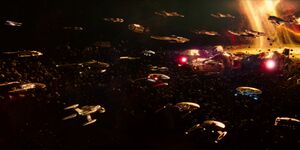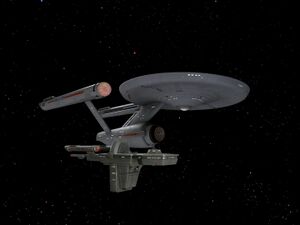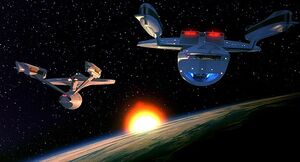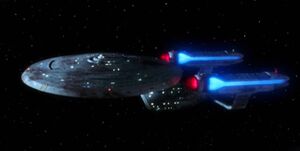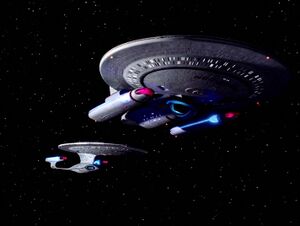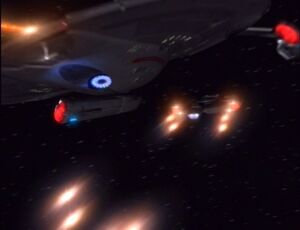Difference between revisions of "History of Starfleet Ship Design"
CrimsonTacit (talk | contribs) |
CrimsonTacit (talk | contribs) |
||
| Line 117: | Line 117: | ||
* For many Starfleet officers, these ships are a reminder of what could have been, had the Dominion War and Borg conflicts not broken out, as they are relatively non-militarized. For some, this sparks feelings of naiveté, and for others the hope of Starfleet at the end of a very long period of peaceful exploration. | * For many Starfleet officers, these ships are a reminder of what could have been, had the Dominion War and Borg conflicts not broken out, as they are relatively non-militarized. For some, this sparks feelings of naiveté, and for others the hope of Starfleet at the end of a very long period of peaceful exploration. | ||
* The youngest ''Miranda''-class starships are approximately the same age as the oldest ''Springfield'' and ''Cheyenne''-class starships, but there is a significant disparity in advancement and capabilities. The same situation exists with the ''Excelsior'' and ''Nebula''-class ships, because the designs from this family are two full generations of advancement ahead of "old-style" starships, as Wesley Crusher put it in TNG: ''The Battle''. | * The youngest ''Miranda''-class starships are approximately the same age as the oldest ''Springfield'' and ''Cheyenne''-class starships, but there is a significant disparity in advancement and capabilities. The same situation exists with the ''Excelsior'' and ''Nebula''-class ships, because the designs from this family are two full generations of advancement ahead of "old-style" starships, as Wesley Crusher put it in TNG: ''The Battle''. | ||
* ''Nebula, Olympic,'' and ''California''-class starships are still being built as of 2399, with the remainder still being maintained and refit but not built from scratch. | |||
== The Borg and Dominion conflicts (2368-2375) == | == The Borg and Dominion conflicts (2368-2375) == | ||
Revision as of 00:37, 16 March 2021
Starfleet shipbuilding has gone through a number of distinct eras as new technologies and construction practices have emerged.
Early Federation (2161-2210s)
At the founding of the Federation in 2161, Starfleet inherited the bulk of Earth's Starfleet, consisting mainly of Daedalus and NX-class starships left over from the Earth-Romulan War. The Columbia-class of the mid-2160s was the first wholly-new Starfleet design and it served as the core of the young fleet, during the long design and construction process of the Bonaventure-class cruiser, which is the signature vessel of this era, her engine designs leading directly to the Constitution-class of the next century. This era saw relatively slow growth of the fleet, as the Federation got its footing as an interstellar power.
Classes Introduced:
- NX-class cruiser
- Intrepid-class light cruiser
- Daedalus-class surveyor
- Columbia-class cruiser
- Bonaventure-class cruiser
Notable technologies introduced:
- Class-1 Warp Drive, Type-V phaser bank (Bonaventure-class)
Golden Age of Exploration (2210s-2260s)
With the Federation's core security established and new members joining each year, Starfleet was forced to expand in the 2210's, with many new starship designs being introduced, starting with the Walker-class. This era would see the rapid introduction of new classes as new advancements were discovered, and by 2256, the fleet had twelve major starship classes in operation simultaneously, speaking to the different construction facilities they hailed from and experiments in starship design. This era saw a wide expansion of Federation territory (which caused notable tensions with its neighbors) and of the total number of member worlds, and so is often seen as a golden era for exploration.
The Constitution-class design was first produced in the 2240s, envisioned as an extremely rare and powerful design with a production run of only 12, until the 2270s when more were authorized. This design largely sat out the Federation-Klingon War of 2256-7, being seen as a weapon of last resort and last hope, should the unthinkable happen. The remainder of the fleet was devastated in this period, leading to standardization in the 2260s.
Classes Introduced:
- Walker-class light cruiser
- Shepard-class frigate
- Cardenas-class heavy cruiser
- Magee-class surveyor
- Kelvin-class science vessel
- Nimitz-class heavy cruiser
- Malachowski-class light cruiser
- Engle-class scout
- Constitution-class heavy cruiser
- Hernandez-class surveyor
- Hoover-class light cruiser
- Crossfield-class science vessel
Notable technologies introduced:
- Class-2 Warp Drive, Type-VI phaser bank, duotronic circuitry (Constitution-class)
Standardization and Consolidation (2260s-2270s)
Following the Federation-Klingon War of 2256-7, Starfleet embarked on a rebuilding program to restore the fleet to it's pre-war size. However, during this process it was discovered that there were simply far too many starship designs in service and more standardization was needed. Starfleet decided to base all future starship designs on the technology found within the Constitution-class heavy cruiser, which was by leaps and bounds the most powerful vessel then in service.
A program of standardization was created so that every ship of the line would have a nearly-identical layout to allow someone trained on a Constitution-class ship to easily find their way on any other ship built during this era, with the exceptions of the Antares-class surveyor (which did not have a primary hull at all) and the Federation-class dreadnought (which had a unique primary hull). Indeed, some hyper-advanced technologies such as holographic communicators were removed wholesale from the fleet, in favor of older, more reliable technologies.
This ethos resulted in the dismantling or reconfiguration of a number of starships built in the previous era, and left the fleet largely homogenous: white hulls with red markings, external deflector dishes, and standardized warp nacelles. The aesthetics of this era for many are synonymous with the Enterprise under James T. Kirk's command, and it remains one of the most iconic and storied time periods in Starfleet history.
Classes Introduced:
- Miranda-class light cruiser
- Hermes-class scout
- Saladin-class frigate
- Antares-class surveyor
- Ptolemy-class tug
- Federation-class dreadnought
Refinement & The Great Experiment (2270s-2330s)
As with the previous era, Starfleet continued its preference for standardization in the 2270s. A new warp engine designed was pioneered aboard the USS Enterprise herself, which served as a model for the refit not only of her class but of the other classes built during the 2260s. This design would become ubiquitous not only for the remainder of the 23rd century but well into the 24th century aboard the Miranda and Constellation-class ships that it spawned. In this era, starship building reached new heights, with the very large Excelsior-class starship introduced with engines that further revolutionized space travel. Despite the success of Excelsior, there was not a second great reconfiguration in the works for Constitution-family starships, and so two generations of engine technology were produced at once, well into the 2330s, by which point the fleet consisted almost entirely of Excelsior, Miranda, and Oberth-class starships, with the Constellation-class and Centaur-class having limited runs of their own.
In this fifty-year period of relative peace and stability, Starfleet expanded to its largest-ever size, with the bulk of its fleet assigned to exploratory duties. Many colonies and starbases were established during this period as well, as the Federation expanded within its own borders.
Classes Introduced:
- Constitution-class refit heavy cruiser
- Miranda-class refit light cruiser
- Akula-class frigate
- Oberth-class surveyor
- Excelsior-class heavy cruiser
- Constellation-class heavy cruiser
- Centaur-class scout
Notable technologies introduced:
- Class-3 warp drive, Type-VII phaser bank (Constitution-class refit)
- Class-4 warp drive, Type-VIII phaser bank (Excelsior-class)
The Ambassador Era (2330s-2350s)
In the early 24th century, the Ambassador-class was introduced as the newest, largest heavy cruiser. This complex, advanced starship introduced a number of innovations including variable atmosphere quarters and phaser strips. It was by far the most effective exploratory platform ever developed, but it was never produced in large numbers due to its resource cost versus the Excelsior-class. A smaller derivative of the Ambassador-class was introduced as a scout: the Freedom-class, but it was also a limited production vessel.
In many ways, shipbuilding stagnated in these decades as Starfleet instead relied on older, proven designs. This was largely because the Federation had not seen sustained combat following the Tomed Incident in 2311. Relations with the Klingons, Romulans, and most other powers were stable, allowing the Federation to continue its successful exploration programs with the starships it already had on hand.
Classes Introduced:
- Ambassador-class heavy cruiser
- Freedom-class scout
Notable technologies introduced:
- Class-5 warp drive, Type-IX phaser array, isolinear circuitry (Ambassador-class)
Fleet Modernization Program (2350s-2368)
Main Article: Fleet Modernization Program
By the 2350s, Starfleet was largely comprised of starships that were designed in the middle of the previous century, with the preference having been to continue large-scale production of the Miranda-class and Constellation-class designs which had their roots in the Constitution-class refit of the 2270s. Indeed, three separate generations of engine design (represented respectively by the Miranda and Oberth, Excelsior, and Ambassador-classes) were in production simultaneously. The Fleet Modernization Program was a concerted and centralized initiative, implemented to replace these aging vessels with new designs that incorporated the latest in defensive, scientific, and propulsion advances. This program was cut short following the Battle of Wolf 359, when it was realized that even these advances weren't enough in the face of an enemy like the Borg.
Classes Introduced:
- Springfield-class science vessel
- Cheyenne-class light cruiser
- Challenger-class scout/courier
- New Orleans-class frigate
- Olympic-class cruiser
- Nebula-class heavy cruiser
- Galaxy-class explorer
- California-class utility cruiser
Notable technology introduced:
- LCARS, modular mission pods (Springfield-class)
- Routine saucer separation and reintegration (Cheyenne-class)
- Type-X phaser array, burst-fire torpedo launcher (New Orleans-class)
- Class-6 warp drive, shipboard holodecks (Galaxy-class)
The Galaxy-class family in play
- Starships built during this era are much more comfortable than those built immediately before them—they're generally also more comfortable than those built during the Dominion War. They have wide hulls with lots of windows, so most everyone's quarters look out into space. Even the oldest vessels in this family have also now been equipped with holodecks.
- For many Starfleet officers, these ships are a reminder of what could have been, had the Dominion War and Borg conflicts not broken out, as they are relatively non-militarized. For some, this sparks feelings of naiveté, and for others the hope of Starfleet at the end of a very long period of peaceful exploration.
- The youngest Miranda-class starships are approximately the same age as the oldest Springfield and Cheyenne-class starships, but there is a significant disparity in advancement and capabilities. The same situation exists with the Excelsior and Nebula-class ships, because the designs from this family are two full generations of advancement ahead of "old-style" starships, as Wesley Crusher put it in TNG: The Battle.
- Nebula, Olympic, and California-class starships are still being built as of 2399, with the remainder still being maintained and refit but not built from scratch.
The Borg and Dominion conflicts (2368-2375)
Following the disastrous encounter with the Borg in 2367, Starfleet began a massive rebuilding and upgrade campaign to create a large number of combat-capable designs that could also fulfill Starfleet's primary exploratory and humanitarian missions. Unlike the previous shipbuilding campaign, these design programs were executed in a number of different initiatives. Generally speaking, the earliest four ships of this era are considered to be the Akira-class family, the Nova and Intrepid-class are a family, and the Sovereign and Prometheus-class are a family, with the remaining classes being one-off designs.
This has led to a return to a high level of fleet diversity not seen since the 2250s. What all of these designs share, however, is a far more combat-oriented approach to starship design. Even the Nova is studded with phaser arrays and has an armored hull. Three of the currently most-powerful starship designs were produced in this era, and it is said that weapons and shield technology made fifty-years worth of advancements in just these seven years of concerted defensive engineering.
Classes introduced:
- Saber-class scout
- Norway-class light cruiser
- Steamrunner-class light cruiser
- Akira-class heavy cruiser
- Nova-class surveyor
- Intrepid-class light explorer
- Defiant-class escort
- Sovereign-class explorer
- Prometheus-class heavy escort
- Galaxy-class Refit (Dreadnought-type) dreadnought
- Typhon-class carrier
Notable technologies introduced:
- Class-7 warp drive, type-X pulse phaser canon (Defiant-class)
- Class-8 warp drive, type-XII phaser array, regenerative shields, quantum torpedo turret (Sovereign-class)
- Class-9 warp drive, bioneural circuitry, EMH (Intrepid-class)
- Multi-vector assault mode, ship-wide holographic projectors (Prometheus-class)
Dominion War-era starships in play
- Largely thanks to CGI, we got an explosion of new ship classes in Star Trek: Deep Space Nine and Star Trek: Voyager, as well as the Next Generation films. While there are definite design similarities between several families of this ship, the fleet is more diverse because the artists weren't literally cutting up models of the Galaxy-class and gluing them together to make them. Starships of this era have fewer windows, more armor, and more angular lines.
- As mentioned above, even the least punchy ships of this era are more punchy than those of the previous one. They were built during a time of war and uncertainty, during which no ship could rely on its non-combat status to save it from battle.
Post-War Renaissance (2375-2385)
Classes introduced:
- Rhode Island-class scout
- Luna-class light explorer
- Argonaut-class light cruiser
- Atlantia-class light cruiser
- Diligent-class frigate
- Parliament-class utility cruiser
- Century-class explorer
- Odyssey-class explorer
Notable technologies introduced:
- Advanced reconfigurable life support (Luna-class)
The New Normal (2385-2399)
Classes introduced:
- Inquiry-class heavy cruiser
- Manticore-class heavy escort
- Vesta-class explorer
- Reliant-class light cruiser
- Resolute-class heavy cruiser
Notable technologies introduced:
- Holographic LCARS interface (Inquiry-class)
- Class-10 warp drive (Vesta-class)

